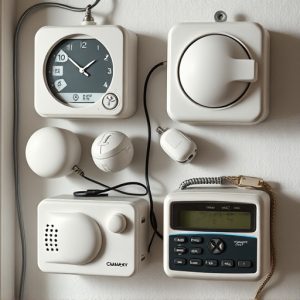Personal Safety Devices for College: Understanding Body-Worn Panic Alarms and Monitoring Systems
Body-worn panic alarms offer powerful personal safety solutions tailored for college students, provi…….
Body-worn panic alarms offer powerful personal safety solutions tailored for college students, providing immediate distress signals via Bluetooth or cellular networks. These compact devices empower users to quickly alert emergency services or trusted contacts with a simple press, enhancing security on large campuses and fostering peace of mind in an increasingly digital world. Choosing the right alarm involves considering range, connectivity, and compatibility with campus security systems while navigating legal and privacy considerations crucial for student empowerment and institutional compliance.
In today’s digital era, ensuring personal safety on college campuses is paramount. One innovative solution gaining traction are body-worn panic alarms, offering students a sense of security. This article explores these personal safety devices, delving into their functionality, benefits, and the importance of choosing the right monitoring system. We’ll also address legal considerations and privacy concerns, providing essential insights for college students navigating this modern safety tool. Understanding body-worn panic alarms can empower students to make informed decisions about their well-being.
- Understanding Body-Worn Panic Alarms: A Personal Safety Device for College Students
- How Do These Devices Work and What Triggers Them?
- Benefits of Wearing a Panic Alarm on Campus
- Choosing the Right Monitoring System for Your Safety
- Legal Considerations and Privacy Concerns for College Students
Understanding Body-Worn Panic Alarms: A Personal Safety Device for College Students
Body-worn panic alarms are personal safety devices designed to provide immediate assistance in emergency situations, making them a valuable tool for college students navigating campus life. These compact and easily portable devices offer a sense of security by allowing users to quickly alert others in case of danger or distress. With a simple press of a button, the alarm triggers a call for help, often connecting the wearer to emergency services or designated support personnel.
For college students, especially those attending large institutions, personal safety is a significant concern. Body-worn alarms offer a discreet yet powerful solution. They can be easily carried on one’s person, ensuring that students have a means of protection while they study, socialize, or travel across campus. This technology empowers individuals to take control of their safety and provides peace of mind in an increasingly digital and mobile world.
How Do These Devices Work and What Triggers Them?
Body-worn panic alarms are designed to provide personal safety devices for college students and other individuals who may need quick access to emergency services. These compact, easily portable devices typically consist of a small alarm button worn on the body, connected to a monitoring system via Bluetooth or cellular networks. When activated, the alarm sends out a distress signal that includes the wearer’s location, allowing emergency responders to swiftly locate and assist them.
The device can be triggered manually by pressing the alarm button, either in response to feeling unsafe or as a means of signaling for help during an emergency situation. Alternatively, some models feature automatic activation mechanisms that detect certain behaviors or conditions, such as sudden falls or lack of movement, which may indicate distress and trigger an alert. This automatic functionality adds a layer of protection, especially in situations where the wearer might be incapacitated or unaware of their surroundings.
Benefits of Wearing a Panic Alarm on Campus
Wearing a panic alarm on campus offers significant advantages in enhancing personal safety devices for college students and staff. These small, yet powerful tools provide immediate assistance during emergencies or distressing situations. With just a simple press of a button, users can alert authorities or trusted contacts nearby, ensuring swift response times. This feature is especially valuable in remote areas of the campus where help might take longer to arrive.
Moreover, body-worn panic alarms encourage a sense of security and empowerment among individuals. Knowing that they have a personal safety device on them can deter potential threats and give users the confidence to navigate campus life without constant worry. This technology complements existing campus security measures, creating a safer environment for everyone involved.
Choosing the Right Monitoring System for Your Safety
Choosing the right monitoring system is an essential step in enhancing personal safety, especially for college students who are often navigating unfamiliar environments. When it comes to body-worn panic alarms, consider factors like range, connectivity, and compatibility with existing security measures. For instance, some devices offer GPS tracking, allowing authorities to pinpoint your location in case of distress. Others integrate with smartphone apps, enabling immediate alerts to emergency contacts.
College students should look for monitoring systems that facilitate easy communication with campus safety services or local emergency responders. This includes clear and concise alarm activation mechanisms, as well as real-time data sharing capabilities. By selecting a comprehensive solution that aligns with your specific needs, you can ensure greater peace of mind while navigating the college experience.
Legal Considerations and Privacy Concerns for College Students
College students’ personal safety is a growing concern, prompting many institutions to explore innovative solutions like body-worn panic alarms with monitoring systems. While these devices offer substantial benefits for student security, they also raise important legal and privacy considerations. With an increasing number of educational facilities adopting such technologies, understanding the regulatory framework becomes crucial.
The implementation of personal safety devices, including panic alarms, must adhere to various laws and guidelines, especially concerning data privacy and protection. College students have a reasonable expectation of privacy, and institutions need to obtain informed consent for monitoring activities, ensuring transparency in data collection and usage practices. Balancing the need for enhanced security with individual freedoms is essential, as it fosters an environment where students feel both safe and empowered.
Body-worn panic alarms have emerged as powerful personal safety devices for college students, offering peace of mind and enhanced security on campus. By understanding how these devices work, leveraging their numerous benefits, and selecting suitable monitoring systems, students can take proactive steps to protect themselves. While legal considerations and privacy concerns must be addressed, the potential for these innovations to revolutionize personal safety in educational institutions is indelible.


